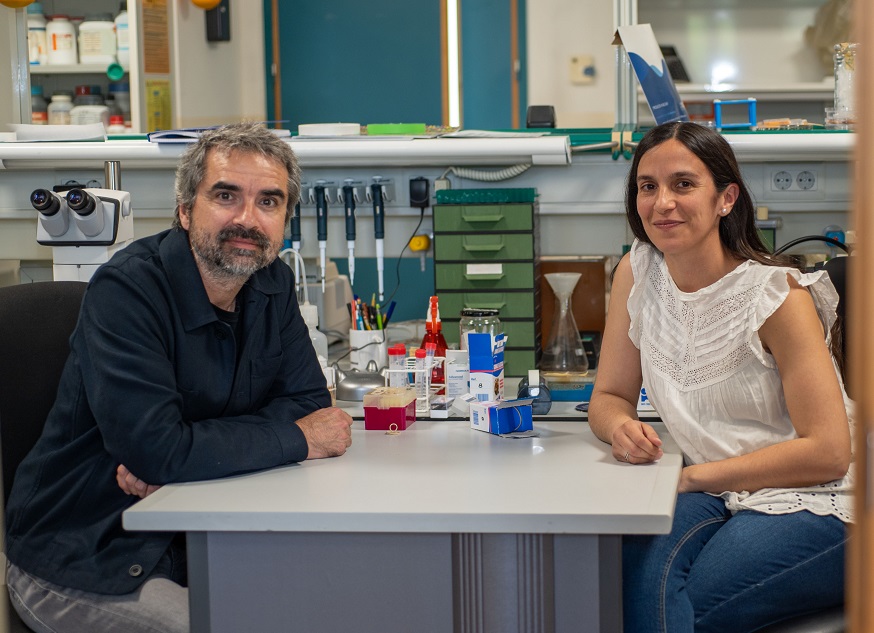Lines of investigation
During development, the release of circulating steroid hormones from neuroendocrine circuits induces a shift from juvenile growth to sexual maturation in humans and insects alike. The initiation of this change is a strictly controlled process, requiring the evaluation of checkpoints based on nutrient levels and growth status to decide whether to activate these neuroendocrine circuits and release steroids that trigger maturation or continue juvenile development.
How exactly these external and internal cues are integrated to dictate when an animal can reach sexual maturity, as well as what molecular and cellular mechanisms acting at the level of neuroendocrine cells trigger this critical decision, remains a fascinating mystery.
Childhood obesity, the prevalence of which is increasing to pandemic proportions, has been associated with precocious puberty in girls. On the other hand, malnutrition and intensive physical training can delay puberty. Previous work in mice and humans has also shown that a deficiency of leptin, a hormone secreted by fat cells, or its receptors, which signal the amount of energy stores in the body in neuroendocrine circuits, leads to hyperphagia, early-onset obesity and delayed or complete inability to initiate the pubertal transition.
By using Drosophila, we aim to uncover the molecular and cellular mechanisms and neuroendocrine circuits required for the regulation of sexual maturation and body weight control.
Representative Publications
- Cirrhosis-downregulated LSECtin can be retrieved by cytokines, shifts the TLR-induced LSECs secretome and correlates with the hepatic Th response. Sebastián Martínez-López, Enrique Ángel-Gomis, Isabel Gómez-Hurtado, Anabel Fernández-Iglesias, Javier Morante, Jordi Gracia-Sancho, Paula Boix, Francisco J. Cubero, Pedro Zapater, Esther Caparrós, Rubén Francés. Liver International. 2024 44(4): 996-1010 https://doi.org/10.1111/liv.15836
- Mammalian puberty: a fly perspective Guirado, J.*, Carranza-Valencia, J.*, Morante, J. FEBS Journal 2023 290 (Issue2): Pages 359-369, January 2023 https://doi.org/10.1111/febs.16534
- Body-fat sensor triggers ribosome maturation in the steroidogenic gland to initiate sexual maturation in Drosophila Juarez-Carreño S, Vallejo DM, Carranza-Valencia J, Palomino-Schätzlein M, Ramon-Cañellas P, Santoro R, de Hartog E, Ferres-Marco D, Romero A, Peterson HP, Ballesta-Illan E, Pineda-Lucena A, Dominguez M, Morante J Cell Rep 2021 37(2):109830 https://doi.org/10.1016/j.celrep.2021.109830
- Neurogenesis From Embryo to Adult – Lessons From Flies and Mice Mira H, Morante J Front Cell Dev Biol 2020 8:533 https://doi.org/10.3389/fcell.2020.00533
- From Early to Late Neurogenesis: Neural Progenitors and the Glial Niche from a Fly’s Point of View Ramon-Cañellas P, Peterson HP, Morante J Neuroscience 2019 399:39 https://doi.org/10.1016/j.neuroscience.2018.12.014
- A brain circuit that synchronizes growth and maturation revealed through Dilp8 binding to Lgr3 Vallejo DM, Juarez-Carreño S, Bolivar J, Morante J, Dominguez M Science 2015 350(6262):aac6767 https://doi.org/10.1126/science.aac6767
- Conserved miR-8/miR-200 Defines a Glial Niche that Controls Neuroepithelial Expansion and Neuroblast Transition Morante J, Vallejo DM, Desplan C, Dominguez M Dev Cell 2013 27(2):174 https://doi.org/10.1016/j.devcel.2013.09.018
- Temporal patterning of Drosophila medulla neuroblasts controls neural fates Xin Li, Ted Erclik, Claire Bertet, Zhenqing Chen, Roumen Voutev, Srinidhi Venkatesh, Javier Morante, Arzu Celik & Claude Desplan Nature 2013 498, pages 456–462 (2013) https://doi.org/10.1038/nature12319
- Cirrhosis-downregulated LSECtin can be retrieved by cytokines, shifts the TLR-induced LSECs secretome and correlates with the hepatic Th response. Sebastián Martínez-López, Enrique Ángel-Gomis, Isabel Gómez-Hurtado, Anabel Fernández-Iglesias, Javier Morante, Jordi Gracia-Sancho, Paula Boix, Francisco J. Cubero, Pedro Zapater, Esther Caparrós, Rubén Francés. Liver International. 2024 44(4): 996-1010 https://doi.org/10.1111/liv.15836
- A Method for Multiple Sampling Mouse Sperm in Vivo. Gonzalo Moreno-del Val, Patricia Muñoz-Robledano, Antonio J Caler, Javier Morante Biol Reprod. 2023 108(2): 197-203 PMID: 36308433 https://doi.org/10.1093/biolre/ioac194
- Mammalian puberty: a fly perspective Guirado, J.*, Carranza-Valencia, J.*, Morante, J. FEBS Journal 2023 290 (Issue2): Pages 359-369, January 2023 https://doi.org/10.1111/febs.16534
- A toolbox to study metabolic status of Drosophila melanogaster larvae Palomino-Schätzlein M, Carranza-Valencia J, Guirado J, Juarez-Carreño S, Morante J STAR Protoc 2022 3(1):101195 https://doi.org/10.1016/j.xpro.2022.101195
- Body-fat sensor triggers ribosome maturation in the steroidogenic gland to initiate sexual maturation in Drosophila Juarez-Carreño S, Vallejo DM, Carranza-Valencia J, Palomino-Schätzlein M, Ramon-Cañellas P, Santoro R, de Hartog E, Ferres-Marco D, Romero A, Peterson HP, Ballesta-Illan E, Pineda-Lucena A, Dominguez M, Morante J Cell Rep 2021 37(2):109830 https://doi.org/10.1016/j.celrep.2021.109830
- Neurogenesis From Embryo to Adult – Lessons From Flies and Mice Mira H, Morante J Front Cell Dev Biol 2020 8:533 https://doi.org/10.3389/fcell.2020.00533
- From Early to Late Neurogenesis: Neural Progenitors and the Glial Niche from a Fly’s Point of View Ramon-Cañellas P, Peterson HP, Morante J Neuroscience 2019 399:39 https://doi.org/10.1016/j.neuroscience.2018.12.014
- Systemic signalling and local effectors in developmental stability, body symmetry, and size Juarez-Carreno S, Morante J, Dominguez M Cell Stress 2018 2(12):340 https://doi.org/10.15698/cst2018.12.167
- A brain circuit that synchronizes growth and maturation revealed through Dilp8 binding to Lgr3 Vallejo DM, Juarez-Carreño S, Bolivar J, Morante J, Dominguez M Science 2015 350(6262):aac6767 https://doi.org/10.1126/science.aac6767
- Conserved miR-8/miR-200 Defines a Glial Niche that Controls Neuroepithelial Expansion and Neuroblast Transition Morante J, Vallejo DM, Desplan C, Dominguez M Dev Cell 2013 27(2):174 https://doi.org/10.1016/j.devcel.2013.09.018
- Temporal patterning of Drosophila medulla neuroblasts controls neural fates Xin Li, Ted Erclik, Claire Bertet, Zhenqing Chen, Roumen Voutev, Srinidhi Venkatesh, Javier Morante, Arzu Celik & Claude Desplan Nature 2013 498, pages 456–462 (2013) https://doi.org/10.1038/nature12319
- Cell migration in Drosophila optic lobe neurons is controlled by eyeless/Pax6 Morante J, Erclik T, Desplan C Development 2011 138(4):687 https://doi.org/10.1242/dev.056069
- Reelin sets the pace of neocortical neurogenesis Lakoma J, Garcia-Alonso L, Luque JM Development 2011 138(23):5223 https://doi.org/10.1242/dev.063776

 Español
Español



